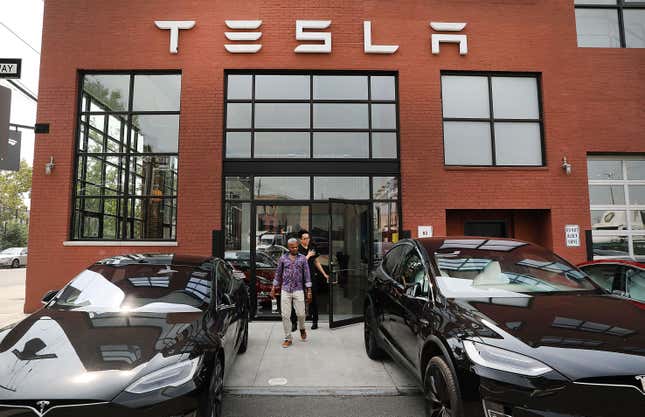
If you’ve called into a Tesla service center in the last few years with a question about less-than-expected range, you might have felt like the company was giving you the run around. A new in-depth report from Reuters found those delays and service cancelations weren’t a bug in a quickly growing company; they were a feature designed to hide discrepancies between advertised, estimated and real-world range.
Tesla reportedly opened what it called a “diversion team” in Las Vegas. The purpose of the team was to do their best to cancel any service requests regarding unusually low range or loss of range. This was because Tesla routinely oversold its vehicle’s range to customers and, due to the explosion in popularity of the company, Tesla didn’t have time to explain to every customer they’d basically been duped. From Reuters:
The Austin, Texas-based electric carmaker deployed the team because its service centers were inundated with appointments from owners who had expected better performance based on the company’s advertised estimates and the projections displayed by the in-dash range meters of the cars themselves, according to several people familiar with the matter.
Inside the Nevada team’s office, some employees celebrated canceling service appointments by putting their phones on mute and striking a metal xylophone, triggering applause from coworkers who sometimes stood on desks. The team often closed hundreds of cases a week and staffers were tracked on their average number of diverted appointments per day.
Managers told the employees that they were saving Tesla about $1,000 for every canceled appointment, the people said. Another goal was to ease the pressure on service centers, some of which had long waits for appointments.
In most cases, the complaining customers’ cars likely did not need repair, according to the people familiar with the matter. Rather, Tesla created the groundswell of complaints another way – by hyping the range of its futuristic electric vehicles, or EVs, raising consumer expectations beyond what the cars can deliver. Teslas often fail to achieve their advertised range estimates and the projections provided by the cars’ own equipment, according to Reuters interviews with three automotive experts who have tested or studied the company’s vehicles.
Tesla’s slow service problems have been well documented in the pre-COVID days, when such delays were frustrating. The company also has a problem being entirely truthful about the range its cars are capable of achieving. The Korea Fair Trade Commission charged Tesla a fine for false advertising and Musk and two legal executives made public mea culpas to their South Korean buyers. The Environmental Protection Agency also told Tesla adjust its range estimates down three percent for the 2020 model year.
How Tesla gets away with goosing its numbers in the U.S. is a little more tricky. As Car And Driver described in detail in 2020. The company is able to game its Environmental Protection Agency range estimate with a special “adjustment factor:”
EVs are strapped to a dynamometer—essentially a treadmill for cars—and repeatedly run through a test regimen that ends only when the battery is depleted to the point that the vehicle can no longer maintain the required speed. This procedure uses the same EPA city cycle (20-mph average speed over 7.5 miles with 18 stops) and highway cycle (48-mph average speed, 10.3 miles) used for fuel-economy tests of all light-duty vehicles. Both cycles feature extremely gentle driving; the most aggressive acceleration would be equivalent to an 18-second 60-mph time. Between city and highway loops, the test calls for a steady speed of 55 or 65 mph to deplete the battery. The EPA knows these low-speed tests aren’t representative of the real world, so every EV’s window-sticker range is the product of an adjustment factor that yields a more realistic consumer-facing figure.
This is where it gets interesting. The default adjustment factor reduces the window-sticker range by 30 percent. So a car that achieves 300 miles of range during the city-cycle dynamometer test ends up with a 210-mile city rating. However, the EPA allows automakers the option to run three additional drive cycles and use those results to earn a more favorable adjustment factor. Currently, only Tesla and Audi employ this strategy for their EVs, and Tesla scores the most advantageous results, with adjustments that range from 29.5 percent on the Model 3 Standard Range Plus to 24.4 percent on the Model Y Performance. If Tesla had used the standard adjustment factor of 30 percent, the Model Y Performance’s window-sticker range would drop to 292 miles. But because Tesla takes advantage of the EPA’s alternate methodology, the company can instead claim a 315-mile range.
Several news outlets and independent testing outfits have found Tesla’s range lagging far behind what it says on the window sticker. So has the rest of the EV industry. Tesla also seems to program cars to show more range to owners when the car is above 50 percent charged, showing more realistic range once the charge gets closer to empty.
When is enough going to be enough when it comes to Tesla? The entire report is an interesting look into how Tesla misled customers and then needed to created an entire corporate culture to keep perpetuating the lie. You can read the whole report here.